Dosing & Uses
Dosage Forms & Strengths
injectable solution
- 50mg/mL
injection, lyophilized powder for reconstitution
- 500mg/vial
- 1000mg/vial
oral suspension
- 200mg/5mL
tablet
- 400mg
- 800mg
capsule
- 200mg
Genital Herpes
Initial treatment: 200 mg PO q4hr while awake (5 times daily) for 10 days or 400 mg PO q8hr for 7-10 days
Intermittent treatment for recurrence: 200 mg PO q4hr while awake (5 times daily) for 5 days; initiate at earliest sign or symptom of recurrence
Chronic suppression for recurrence: 400 mg PO q12hr for up to 12 months; alternatively, 200 mg 3-5 times daily
Herpes Simplex Virus Encephalitis
10-15 mg/kg IV q8hr for 10 days; up to 14-21 days reported
Mucocutaneous Herpes Simplex Virus Infection
Treatment in immunocompromised patients
IV: 5 mg/kg q8hr for 7 days; dosing up to 14 days reported
PO (off-label): 400 mg q4hr while awake (5 times daily) for 7 days
Herpes Zoster (Shingles)
Acute treatment: 800 mg PO q4hr while awake (5 times daily) for 7-10 days
Immunocompromised patients
- 10 mg/kg IV q8hr for 7 days
- CrCl 25-50 mL/min: Full recommended IV dose q12hr
- CrCl 10-25 mL/min: Full recommended IV dose once daily
- CrCl 0-10 mL/min: 50% of recommended IV dose once daily
Varicella Zoster (Chickenpox)
>40 kg (immunocompetent): 800 mg PO q6hr for 5 days
Immunocompromised patients: 10-15 mg/kg IV q8hr for 7-10 days
Dosage Modifications
Dose adjustment based on renal clearance and normal dosage regimen
200 mg every 4 hr
- <10 mL/min/1.73 m²: 200 mg q12hr
- ≥10 mL/min/1.73 m²: 200 mg q4hr (five times daily)
400 mg every 12 hr
- <10 mL/min/1.73 m²: 200 mg q12hr
- ≥10 mL/min/1.73 m²: 400 mg q12hr
800 mg every 4 hr
- <10 mL/min/1.73 m²: 800 mg q12hr
- 10-25 mL/min/1.73 m²: 800 mg q8hr
- >25 mL/min/1.73 m²: 800 mg q4hr (five times daily)
Dose adjustment based on dosage form
Renal impairment (IV)
- CrCl 25-50 mL/min/1.73 m²: Give recommended dose q12hr
- CrCl 10-25 mL/min/1.73 m²: Give recommended dose q24hr
- CrCl <10 mL/min/1.73 m²: Give 50% of recommended dose q24hr
Renal impairment (PO)
- Normal dosage 200 mg q4hr or 400 mg q12hr and CrCl <10 mL/min/1.73 m²: Decrease to 200 mg q12hr
- Normal dosage 800 mg q4hr and CrCl 10-25 mL/min/1.73 m²: Decrease to 800 mg q8hr
- Normal dosage 800 mg q4hr and CrCl <10 mL/min/1.73 m²: Decrease to 800 mg q12hr
Herpetic Keratitis (Orphan)
Orphan designation for treatment of herpetic keratitis
Sponsor
- Cumulus Pharmaceuticals LLC; 1712 Pioneer Avenue, Suite 1377; Cheyenne, Wyoming 82001
Dosage Forms & Strengths
injectable solution
- 50mg/mL
injection, lyophilized powder for reconstitution
- 500mg/vial
- 1000mg/vial
oral suspension
- 200mg/5mL
powder for injection
- 500mg/vial
- 1g/vial
tablet
- 400mg
- 800mg
capsule
- 200mg
Neonatal Herpes Simplex Virus Infection
Following doses based on research of the NIH National Institute of Child Health and Human Development (NICHD) that updated prescribing information was based on
Infuse IV over 1 hr
PMA ≥34 weeks: 20 mg/kg IV q8hr for 21 days
PMA <34 weeks: 20 mg/kg IV q12hr for 21 days
Caution if renal function beyond the effect of prematurity occurs
Herpes Simplex Virus Encephalitis
3 months-12 years: 20 mg/kg IV q8hr for 10 days; up to 14-21 days reported
≥12 years: 10-15 mg/kg IV q8hr for 14-21 days
Mucocutaneous Herpes Simplex Virus Infection
Treatment in immunocompromised patients
<12 years: 10 mg/kg IV q8hr for 7 days
≥12 years: 5-10 mg/kg/day IV divided q8hr for 5-7 days; up to 14 days reported
Herpes Zoster (Shingles)
<12 years (immunocompromised): 20 mg/kg IV q8hr for 7 days
≥12 years (immunocompetent): 800 mg PO q4hr while awake (5 times daily) for 7-10 days
≥12 years (immunocompromised): 30 mg/kg/day IV divided q8hr for 7-10 days
Varicella Zoster (Chickenpox)
≥2 years and <40 kg: 20 mg/kg/dose PO q6hr for 5 days; not to exceed 800 mg/dose
≥40 kg: 800 mg PO q6hr for 5 days
Immunocompromised patients
- <12 years: 20 mg/kg/dose IV q8hr for 7 days
- ≥12 years: 10 mg/kg/dose IV q8hr for 7 days
Dosing Considerations
Use ideal body weight (IBW) for obese patients
Interactions
Interaction Checker
No Results

Contraindicated
Serious - Use Alternative
Significant - Monitor Closely
Minor

Contraindicated (0)
Serious - Use Alternative (5)
- amphotericin B deoxycholate
acyclovir and amphotericin B deoxycholate both increase nephrotoxicity and/or ototoxicity. Avoid or Use Alternate Drug.
- bacitracin
acyclovir and bacitracin both increase nephrotoxicity and/or ototoxicity. Avoid or Use Alternate Drug. Avoid concurrent use of bacitracin with other nephrotoxic drugs
- cidofovir
acyclovir and cidofovir both increase nephrotoxicity and/or ototoxicity. Avoid or Use Alternate Drug.
- neomycin PO
acyclovir and neomycin PO both increase nephrotoxicity and/or ototoxicity. Avoid or Use Alternate Drug.
- talimogene laherparepvec
acyclovir decreases effects of talimogene laherparepvec by pharmacodynamic antagonism. Avoid or Use Alternate Drug. Although no drug interactions studies have been performed, antiherpetic viral agents may interfere with the effectiveness of talimogene laherparepvec.
Monitor Closely (27)
- amikacin
acyclovir and amikacin both increase nephrotoxicity and/or ototoxicity. Modify Therapy/Monitor Closely.
- amoxicillin
amoxicillin, acyclovir. Either increases levels of the other by decreasing renal clearance. Use Caution/Monitor.
- capreomycin
acyclovir and capreomycin both increase nephrotoxicity and/or ototoxicity. Use Caution/Monitor.
- carboplatin
acyclovir and carboplatin both increase nephrotoxicity and/or ototoxicity. Use Caution/Monitor.
- cephaloridine
acyclovir and cephaloridine both increase nephrotoxicity and/or ototoxicity. Use Caution/Monitor.
- cisplatin
acyclovir and cisplatin both increase nephrotoxicity and/or ototoxicity. Use Caution/Monitor.
- colistin
acyclovir and colistin both increase nephrotoxicity and/or ototoxicity. Use Caution/Monitor.
- contrast media (iodinated)
acyclovir and contrast media (iodinated) both increase nephrotoxicity and/or ototoxicity. Modify Therapy/Monitor Closely.
- cyclosporine
acyclovir and cyclosporine both increase nephrotoxicity and/or ototoxicity. Modify Therapy/Monitor Closely.
- elvitegravir/cobicistat/emtricitabine/tenofovir DF
acyclovir, elvitegravir/cobicistat/emtricitabine/tenofovir DF. Either increases toxicity of the other by decreasing renal clearance. Use Caution/Monitor. Toxicity may result from coadministration of emtricitabine and tenofovir with other drugs that are also primarily excreted by glomerular filtration and/or active tubular secretion .
acyclovir and elvitegravir/cobicistat/emtricitabine/tenofovir DF both increase nephrotoxicity and/or ototoxicity. Use Caution/Monitor. - emtricitabine
acyclovir increases levels of emtricitabine by Other (see comment). Use Caution/Monitor. Comment: Coadministration of emtricitabine with drugs that reduce renal function or compete for active tubular secretion may increase serum concentrations of emtricitabine.
- gentamicin
acyclovir and gentamicin both increase nephrotoxicity and/or ototoxicity. Use Caution/Monitor.
- ioversol
acyclovir and ioversol both increase nephrotoxicity and/or ototoxicity. Modify Therapy/Monitor Closely.
- mycophenolate
acyclovir will increase the level or effect of mycophenolate by acidic (anionic) drug competition for renal tubular clearance. Use Caution/Monitor.
- oxaliplatin
acyclovir and oxaliplatin both increase nephrotoxicity and/or ototoxicity. Use Caution/Monitor.
- peramivir
acyclovir increases levels of peramivir by decreasing renal clearance. Use Caution/Monitor. Caution when peramivir coadministered with nephrotoxic drugs.
- pivmecillinam
pivmecillinam, acyclovir. Either increases levels of the other by decreasing renal clearance. Use Caution/Monitor.
- polymyxin B
acyclovir and polymyxin B both increase nephrotoxicity and/or ototoxicity. Use Caution/Monitor.
- probenecid
acyclovir will increase the level or effect of probenecid by acidic (anionic) drug competition for renal tubular clearance. Use Caution/Monitor.
- streptozocin
acyclovir and streptozocin both increase nephrotoxicity and/or ototoxicity. Use Caution/Monitor.
- tacrolimus
acyclovir and tacrolimus both increase nephrotoxicity and/or ototoxicity. Modify Therapy/Monitor Closely.
- teicoplanin
acyclovir and teicoplanin both increase nephrotoxicity and/or ototoxicity. Modify Therapy/Monitor Closely.
- temocillin
temocillin, acyclovir. Either increases levels of the other by decreasing renal clearance. Use Caution/Monitor.
- tenofovir DF
acyclovir and tenofovir DF both increase nephrotoxicity and/or ototoxicity. Use Caution/Monitor.
acyclovir increases levels of tenofovir DF by Other (see comment). Use Caution/Monitor. Comment: Coadministration of tenofovir with drugs that reduce renal function or compete for active tubular secretion may increase serum concentrations of tenofovir. - ticarcillin
ticarcillin, acyclovir. Either increases levels of the other by decreasing renal clearance. Use Caution/Monitor.
- tobramycin
acyclovir and tobramycin both increase nephrotoxicity and/or ototoxicity. Use Caution/Monitor.
- ublituximab
ublituximab decreases effects of acyclovir by immunosuppressive effects; risk of infection. Use Caution/Monitor.
Minor (62)
- aceclofenac
aceclofenac will increase the level or effect of acyclovir by acidic (anionic) drug competition for renal tubular clearance. Minor/Significance Unknown.
- acemetacin
acemetacin will increase the level or effect of acyclovir by acidic (anionic) drug competition for renal tubular clearance. Minor/Significance Unknown.
- adefovir
acyclovir and adefovir both increase nephrotoxicity and/or ototoxicity. Minor/Significance Unknown.
- aminohippurate sodium
acyclovir will increase the level or effect of aminohippurate sodium by acidic (anionic) drug competition for renal tubular clearance. Minor/Significance Unknown.
- aspirin
aspirin will increase the level or effect of acyclovir by acidic (anionic) drug competition for renal tubular clearance. Minor/Significance Unknown.
- aspirin rectal
aspirin rectal will increase the level or effect of acyclovir by acidic (anionic) drug competition for renal tubular clearance. Minor/Significance Unknown.
- aspirin/citric acid/sodium bicarbonate
aspirin/citric acid/sodium bicarbonate will increase the level or effect of acyclovir by acidic (anionic) drug competition for renal tubular clearance. Minor/Significance Unknown.
- astragalus
astragalus increases effects of acyclovir by pharmacodynamic synergism. Minor/Significance Unknown.
- balsalazide
balsalazide will increase the level or effect of acyclovir by acidic (anionic) drug competition for renal tubular clearance. Minor/Significance Unknown.
- bendroflumethiazide
bendroflumethiazide will increase the level or effect of acyclovir by acidic (anionic) drug competition for renal tubular clearance. Minor/Significance Unknown.
- cefadroxil
cefadroxil will increase the level or effect of acyclovir by acidic (anionic) drug competition for renal tubular clearance. Minor/Significance Unknown.
- cefamandole
cefamandole will increase the level or effect of acyclovir by acidic (anionic) drug competition for renal tubular clearance. Minor/Significance Unknown.
- cefpirome
cefpirome will increase the level or effect of acyclovir by acidic (anionic) drug competition for renal tubular clearance. Minor/Significance Unknown.
- ceftazidime
ceftazidime will increase the level or effect of acyclovir by acidic (anionic) drug competition for renal tubular clearance. Minor/Significance Unknown.
- celecoxib
celecoxib will increase the level or effect of acyclovir by acidic (anionic) drug competition for renal tubular clearance. Minor/Significance Unknown.
- cephalexin
cephalexin will increase the level or effect of acyclovir by acidic (anionic) drug competition for renal tubular clearance. Minor/Significance Unknown.
- chlorothiazide
chlorothiazide will increase the level or effect of acyclovir by acidic (anionic) drug competition for renal tubular clearance. Minor/Significance Unknown.
- chlorpropamide
acyclovir will increase the level or effect of chlorpropamide by acidic (anionic) drug competition for renal tubular clearance. Minor/Significance Unknown.
- chlorthalidone
chlorthalidone will increase the level or effect of acyclovir by acidic (anionic) drug competition for renal tubular clearance. Minor/Significance Unknown.
- choline magnesium trisalicylate
choline magnesium trisalicylate will increase the level or effect of acyclovir by acidic (anionic) drug competition for renal tubular clearance. Minor/Significance Unknown.
- cyclopenthiazide
cyclopenthiazide will increase the level or effect of acyclovir by acidic (anionic) drug competition for renal tubular clearance. Minor/Significance Unknown.
- diclofenac
diclofenac will increase the level or effect of acyclovir by acidic (anionic) drug competition for renal tubular clearance. Minor/Significance Unknown.
- diflunisal
diflunisal will increase the level or effect of acyclovir by acidic (anionic) drug competition for renal tubular clearance. Minor/Significance Unknown.
- etodolac
etodolac will increase the level or effect of acyclovir by acidic (anionic) drug competition for renal tubular clearance. Minor/Significance Unknown.
- fenoprofen
fenoprofen will increase the level or effect of acyclovir by acidic (anionic) drug competition for renal tubular clearance. Minor/Significance Unknown.
- flurbiprofen
flurbiprofen will increase the level or effect of acyclovir by acidic (anionic) drug competition for renal tubular clearance. Minor/Significance Unknown.
- foscarnet
acyclovir and foscarnet both increase nephrotoxicity and/or ototoxicity. Minor/Significance Unknown.
- ganciclovir
acyclovir will increase the level or effect of ganciclovir by acidic (anionic) drug competition for renal tubular clearance. Minor/Significance Unknown.
- hydrochlorothiazide
hydrochlorothiazide will increase the level or effect of acyclovir by acidic (anionic) drug competition for renal tubular clearance. Minor/Significance Unknown.
- ibuprofen
ibuprofen will increase the level or effect of acyclovir by acidic (anionic) drug competition for renal tubular clearance. Minor/Significance Unknown.
- ibuprofen IV
ibuprofen IV will increase the level or effect of acyclovir by acidic (anionic) drug competition for renal tubular clearance. Minor/Significance Unknown.
- indapamide
indapamide will increase the level or effect of acyclovir by acidic (anionic) drug competition for renal tubular clearance. Minor/Significance Unknown.
- indomethacin
indomethacin will increase the level or effect of acyclovir by acidic (anionic) drug competition for renal tubular clearance. Minor/Significance Unknown.
- ketoprofen
ketoprofen will increase the level or effect of acyclovir by acidic (anionic) drug competition for renal tubular clearance. Minor/Significance Unknown.
- ketorolac
ketorolac will increase the level or effect of acyclovir by acidic (anionic) drug competition for renal tubular clearance. Minor/Significance Unknown.
- ketorolac intranasal
ketorolac intranasal will increase the level or effect of acyclovir by acidic (anionic) drug competition for renal tubular clearance. Minor/Significance Unknown.
- lornoxicam
lornoxicam will increase the level or effect of acyclovir by acidic (anionic) drug competition for renal tubular clearance. Minor/Significance Unknown.
- meclofenamate
meclofenamate will increase the level or effect of acyclovir by acidic (anionic) drug competition for renal tubular clearance. Minor/Significance Unknown.
- mefenamic acid
mefenamic acid will increase the level or effect of acyclovir by acidic (anionic) drug competition for renal tubular clearance. Minor/Significance Unknown.
- meloxicam
meloxicam will increase the level or effect of acyclovir by acidic (anionic) drug competition for renal tubular clearance. Minor/Significance Unknown.
- mesalamine
mesalamine will increase the level or effect of acyclovir by acidic (anionic) drug competition for renal tubular clearance. Minor/Significance Unknown.
- methoxyflurane
acyclovir and methoxyflurane both increase nephrotoxicity and/or ototoxicity. Minor/Significance Unknown.
- methyclothiazide
methyclothiazide will increase the level or effect of acyclovir by acidic (anionic) drug competition for renal tubular clearance. Minor/Significance Unknown.
- metolazone
metolazone will increase the level or effect of acyclovir by acidic (anionic) drug competition for renal tubular clearance. Minor/Significance Unknown.
- nabumetone
nabumetone will increase the level or effect of acyclovir by acidic (anionic) drug competition for renal tubular clearance. Minor/Significance Unknown.
- naproxen
naproxen will increase the level or effect of acyclovir by acidic (anionic) drug competition for renal tubular clearance. Minor/Significance Unknown.
- oxaprozin
oxaprozin will increase the level or effect of acyclovir by acidic (anionic) drug competition for renal tubular clearance. Minor/Significance Unknown.
- parecoxib
parecoxib will increase the level or effect of acyclovir by acidic (anionic) drug competition for renal tubular clearance. Minor/Significance Unknown.
- paromomycin
acyclovir and paromomycin both increase nephrotoxicity and/or ototoxicity. Minor/Significance Unknown.
- pentamidine
acyclovir and pentamidine both increase nephrotoxicity and/or ototoxicity. Minor/Significance Unknown.
- piroxicam
piroxicam will increase the level or effect of acyclovir by acidic (anionic) drug competition for renal tubular clearance. Minor/Significance Unknown.
- rose hips
rose hips will increase the level or effect of acyclovir by acidic (anionic) drug competition for renal tubular clearance. Minor/Significance Unknown.
- salicylates (non-asa)
salicylates (non-asa) will increase the level or effect of acyclovir by acidic (anionic) drug competition for renal tubular clearance. Minor/Significance Unknown.
- salsalate
salsalate will increase the level or effect of acyclovir by acidic (anionic) drug competition for renal tubular clearance. Minor/Significance Unknown.
- streptomycin
acyclovir and streptomycin both increase nephrotoxicity and/or ototoxicity. Minor/Significance Unknown.
- sulfasalazine
sulfasalazine will increase the level or effect of acyclovir by acidic (anionic) drug competition for renal tubular clearance. Minor/Significance Unknown.
- sulindac
sulindac will increase the level or effect of acyclovir by acidic (anionic) drug competition for renal tubular clearance. Minor/Significance Unknown.
- tolfenamic acid
tolfenamic acid will increase the level or effect of acyclovir by acidic (anionic) drug competition for renal tubular clearance. Minor/Significance Unknown.
- tolmetin
tolmetin will increase the level or effect of acyclovir by acidic (anionic) drug competition for renal tubular clearance. Minor/Significance Unknown.
- valganciclovir
acyclovir will increase the level or effect of valganciclovir by acidic (anionic) drug competition for renal tubular clearance. Minor/Significance Unknown.
- vancomycin
acyclovir and vancomycin both increase nephrotoxicity and/or ototoxicity. Minor/Significance Unknown.
- willow bark
willow bark will increase the level or effect of acyclovir by acidic (anionic) drug competition for renal tubular clearance. Minor/Significance Unknown.
Adverse Effects
>10%
Oral
- Malaise (≤12%)
1-10%
Parenteral
- Inflammation or phlebitis at injection site (9%)
- Nausea (7%)
- Vomiting (7%)
- Rash or hives (2%)
- Elevated transaminase levels (1-2%)
Oral
- Nausea (2-5%)
- Vomiting (≤3%)
- Diarrhea (2-3%)
- Headache (2%)
<1%
Abdominal pain
Aggression/confusion
Agitation
Alopecia
Anaphylaxis
Anemia
Angioedema
Anorexia
Ataxia
Coma
Disseminated intravascular coagulation (DIC)
Dizziness
Fatigue
Warnings
Contraindications
Hypersensitivity
Cautions
Avoid rapid infusion because of risk of renal damage
Renal failure, resulting in death, has occurred
Use with caution in immunocompromised patients (potential risk of thrombotic thrombocytopenic purpura [TTP]/hemolytic uremic syndrome [HUS])
Use with caution in patients with renal impairment
Treatment should begin within 24 hours of appearance of rash
Use with caution in patients receiving nephrotoxic drugs
Maintain adequate hydration during PO or IV therapy
Thrombocytopenic purpura/hemolytic uremic syndrome reported
Pregnancy & Lactation
Pregnancy
Drug is minimally absorbed systemically following topical route of administration, and maternal use is not expected to result in fetal exposure to drug; experience with topical acyclovir use in pregnant women over several decades, based on published literature including observational studies, has not identified a drug-associated risk of major birth defects, miscarriage or adverse maternal or fetal outcomes
Animal data
- Animal reproduction studies with systemic exposure of acyclovir have been conducted; refer to acyclovir prescribing information for additional details
Lactation
Drug is minimally absorbed systemically following topical route of administration, and breastfeeding is not expected to result in exposure of child to drug; there are no data on effects of drug on breastfed infant or on milk production; Developmental and health benefits of breastfeeding should be considered along with mother’s clinical need for therapy and any potential adverse effects on breastfed child from drug or from underlying maternal condition
Pregnancy Categories
A: Generally acceptable. Controlled studies in pregnant women show no evidence of fetal risk.
B: May be acceptable. Either animal studies show no risk but human studies not available or animal studies showed minor risks and human studies done and showed no risk. C: Use with caution if benefits outweigh risks. Animal studies show risk and human studies not available or neither animal nor human studies done. D: Use in LIFE-THREATENING emergencies when no safer drug available. Positive evidence of human fetal risk. X: Do not use in pregnancy. Risks involved outweigh potential benefits. Safer alternatives exist. NA: Information not available.Pharmacology
Mechanism of Action
Interferes with DNA polymerase to inhibit DNA replication via chain termination
Absorption
Absorption: PO, 15-30%
Peak serum time: 1.5-2 hr (PO); 1 hr (IV)
Distribution
Distributed widely (brain, kidney, lungs, liver, spleen, muscle, uterus, vagina, cerebrospinal fluid [CSF])
Protein bound: 9-33%
Vd: 0.8 L/kg (63.6 L)
Metabolism
Metabolized by liver (in small amounts)
Elimination
Half-life: 4 hr (Neonates); 2-3 hr (children 1-12 years); 3 hr (adults)
Excretion: Urine (62-90% as unchanged drug)
Administration
IV Incompatibilities
Blood products and protein-containing solutions
Additive: Dobutamine, dopamine, meropenem (?)
Syringe: Caffeine
Y-site: Amifostine, amsacrine, aztreonam, cefepime, dobutamine, dopamine, fludarabine, foscarnet, gemcitabine, idarubicin, levofloxacin, morphine sulfate (?), ondansetron, piperacillin-tazobactam, sargramostim, vinorelbine
IV Compatibilities
Additive: Fluconazole
Y-site (partial list): Allopurinol, ampicillin, cefazolin, cimetidine, diphenhydramine, fluconazole, heparin, linezolid, lorazepam, magnesium sulfate, potassium chloride, propofol, trimethoprim-sulfamethoxazole, vancomycin
IV Preparation
Lyophilized powder
- Reconstitute with 10 mL (500-mg vial) or 20 mL (1000-mg vial) with Sterile Water
- Do not bacteriostatic water containing benzyl alcohol
- Concentrations >10 mg/mL increase risk of phlebitis; usually recommended not to exceed 7 mg/mL in D5W
Injection
- For IV infusion, dilute solution in D5W or 0.9% NaCl to a final concentration ≤7 mg/mL. Concentrations >10 mg/mL increase the risk of phlebitis
IV Administration
For IV infusion only
Avoid rapid infusion; infuse over 1 hr at constant rate to prevent renal damage
Maintain adequate hydration
Check for phlebitis, and rotate infusion sites
Storage
Capsule, oral suspension, tablet: Store at room temperature of 15-25°C (59-77°F); protect from moisture
Powder for injection: Store undiluted vials at 15-25°C (59-77°F); following reconstitution (final concentration 50 mg/mL), solution is stable for 12 hr at room temperature
Solution for injection: Store solution at 20-25°C (68-77°F)
Reconstituted solutions: Do not refrigerate; once diluted with 0.9% NaCl or D5W, use within 24 hr
Images
| BRAND | FORM. | UNIT PRICE | PILL IMAGE |
|---|---|---|---|
| acyclovir oral - | 400 mg tablet | 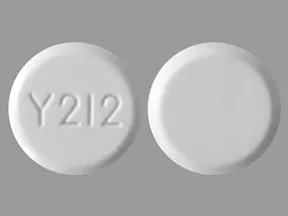 | |
| acyclovir oral - | 800 mg tablet | 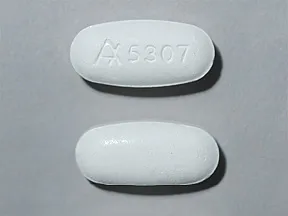 | |
| acyclovir oral - | 200 mg capsule | 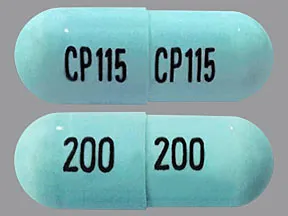 | |
| acyclovir oral - | 200 mg capsule | 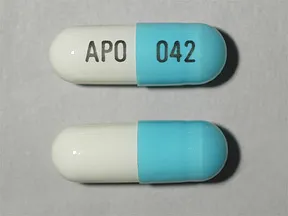 | |
| acyclovir oral - | 800 mg tablet | 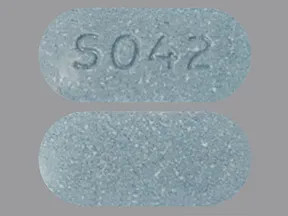 | |
| acyclovir oral - | 400 mg tablet | 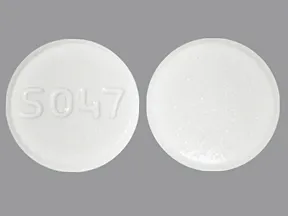 | |
| acyclovir oral - | 400 mg tablet | 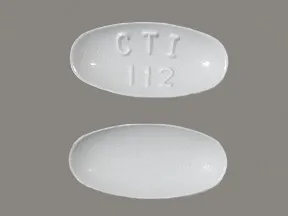 | |
| acyclovir oral - | 200 mg capsule |  | |
| acyclovir oral - | 800 mg tablet | 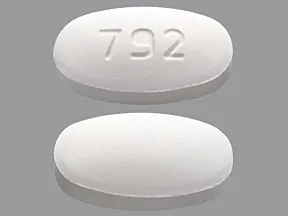 | |
| acyclovir oral - | 400 mg tablet | 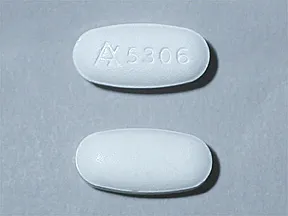 | |
| acyclovir oral - | 200 mg capsule | 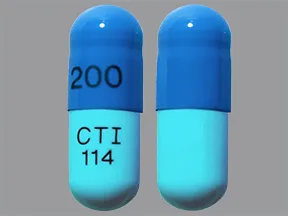 | |
| acyclovir oral - | 800 mg tablet | 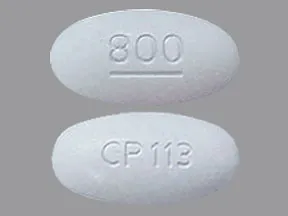 | |
| acyclovir oral - | 400 mg tablet | 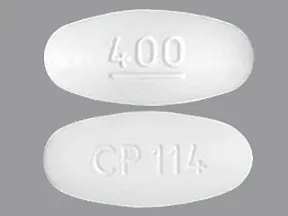 | |
| acyclovir oral - | 200 mg capsule | 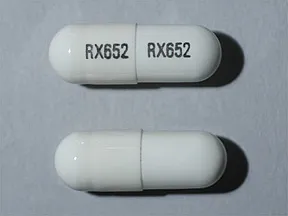 | |
| acyclovir oral - | 800 mg tablet | 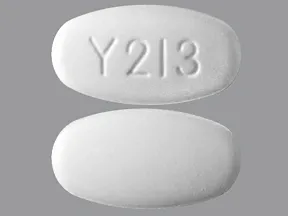 | |
| acyclovir oral - | 400 mg tablet | 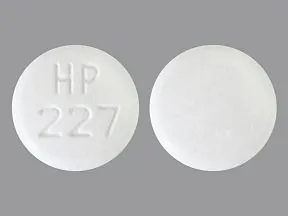 | |
| acyclovir oral - | 200 mg capsule |  | |
| acyclovir oral - | 800 mg tablet |  | |
| acyclovir oral - | 400 mg tablet | 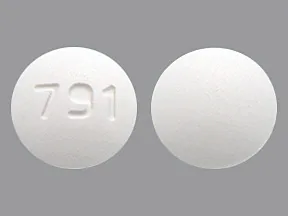 | |
| acyclovir oral - | 400 mg tablet |  | |
| acyclovir oral - | 800 mg tablet | 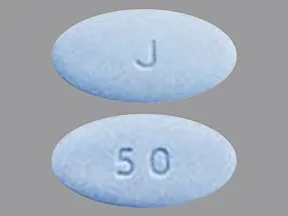 | |
| acyclovir oral - | 200 mg capsule | 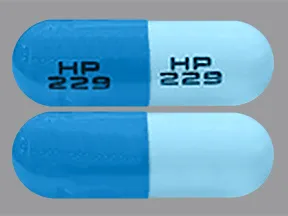 | |
| acyclovir oral - | 200 mg capsule | 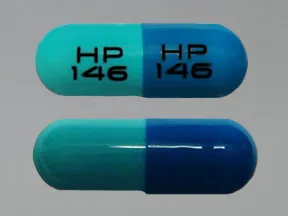 | |
| acyclovir oral - | 200 mg/5 mL suspension | 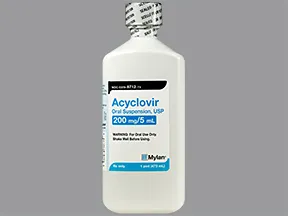 | |
| acyclovir oral - | 200 mg/5 mL suspension | 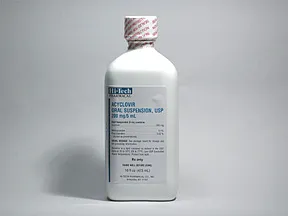 | |
| acyclovir oral - | 200 mg/5 mL suspension | 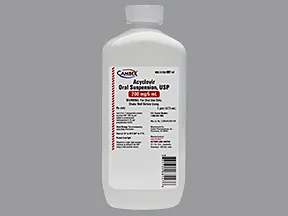 | |
| acyclovir oral - | 800 mg tablet | 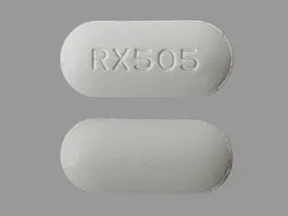 | |
| acyclovir oral - | 800 mg tablet | 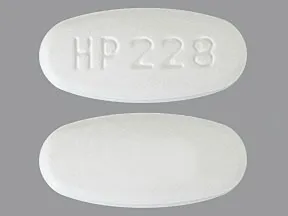 | |
| acyclovir oral - | 200 mg/5 mL suspension | 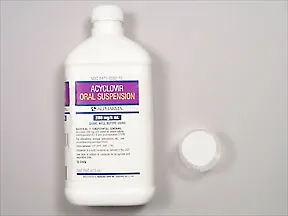 | |
| Zovirax topical - | 5 % ointment |  | |
| Zovirax topical - | 5 % cream | 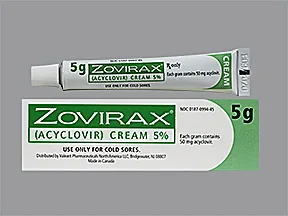 | |
| acyclovir topical - | 5 % ointment | 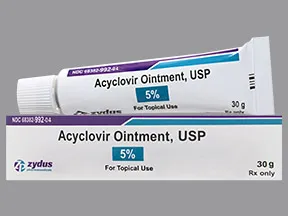 | |
| acyclovir topical - | 5 % ointment | 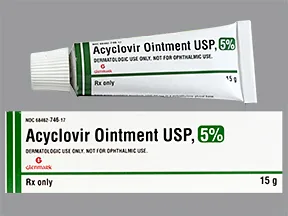 | |
| acyclovir topical - | 5 % ointment |  | |
| acyclovir topical - | 5 % ointment |  | |
| acyclovir topical - | 5 % cream | 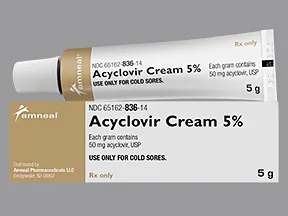 | |
| acyclovir topical - | 5 % ointment | 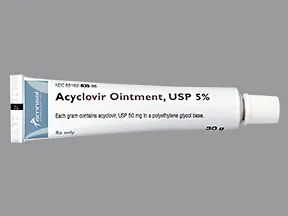 | |
| acyclovir topical - | 5 % ointment | 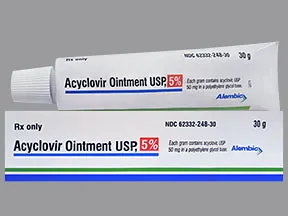 | |
| acyclovir topical - | 5 % ointment | 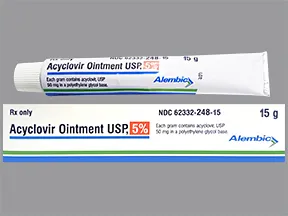 | |
| acyclovir topical - | 5 % ointment | 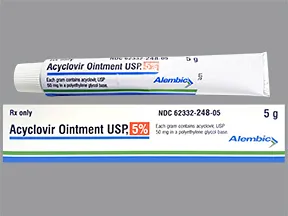 | |
| acyclovir topical - | 5 % ointment |  | |
| acyclovir topical - | 5 % ointment | 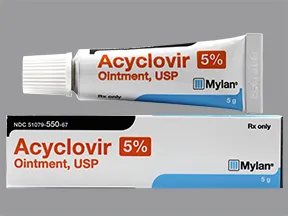 | |
| acyclovir topical - | 5 % ointment | 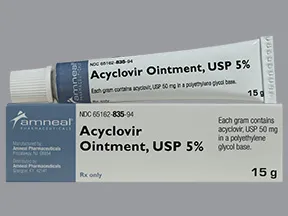 | |
| acyclovir topical - | 5 % ointment |  | |
| acyclovir topical - | 5 % ointment |  | |
| acyclovir topical - | 5 % ointment | 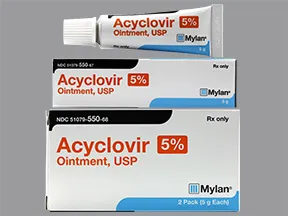 | |
| acyclovir topical - | 5 % ointment | 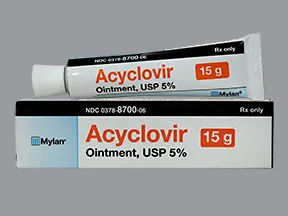 | |
| acyclovir topical - | 5 % ointment | 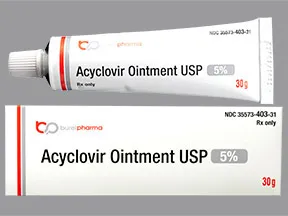 | |
| acyclovir topical - | 5 % ointment | 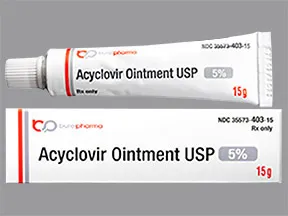 | |
| acyclovir topical - | 5 % cream | 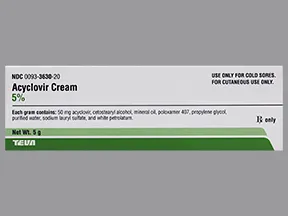 | |
| acyclovir topical - | 5 % ointment | 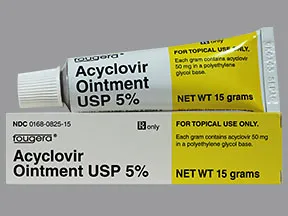 | |
| acyclovir topical - | 5 % cream | 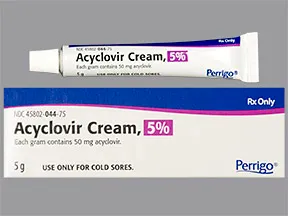 | |
| acyclovir topical - | 5 % ointment |  | |
| acyclovir topical - | 5 % ointment |  | |
| acyclovir topical - | 5 % ointment | 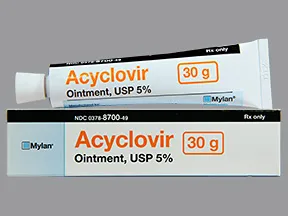 |
Copyright © 2010 First DataBank, Inc.
Patient Handout
acyclovir oral
ACYCLOVIR - ORAL
(ay-SYE-kloe-vir)
COMMON BRAND NAME(S): Zovirax
USES: Acyclovir is used to treat infections caused by certain types of viruses. It treats cold sores around the mouth (caused by herpes simplex), shingles (caused by herpes zoster), and chickenpox.This medication is also used to treat outbreaks of genital herpes. In people with frequent outbreaks, acyclovir is used to help reduce the number of future episodes.Acyclovir is an antiviral drug. However, it is not a cure for these infections. The viruses that cause these infections continue to live in the body even between outbreaks. Acyclovir decreases the severity and length of these outbreaks. It helps the sores heal faster, keeps new sores from forming, and decreases pain/itching. This medication may also help reduce how long pain remains after the sores heal. In addition, in people with a weakened immune system, acyclovir can decrease the risk of the virus spreading to other parts of the body and causing serious infections.
HOW TO USE: Take this medication by mouth with or without food as directed by your doctor, usually 2 to 5 times a day. Drink plenty of fluids while taking this medication unless your doctor directs you otherwise.If you are using the liquid form of this medication, shake the bottle well before each dose. Carefully measure the dose using a special measuring device/spoon. Do not use a household spoon because you may not get the correct dose.This medication works best when started at the first sign of an outbreak, as directed by your doctor. It may not work as well if you delay treatment.The dosage is based on your medical condition and response to treatment. In children, the dosage is also based on weight.This medication works best when the amount of drug in your body is kept at a constant level. Take this drug at evenly spaced intervals. To help you remember, take it at the same times each day.Continue to take this medication until the full prescribed amount is finished. Do not change your dose, skip any doses, or stop this medication early without your doctor's approval.Tell your doctor if your condition lasts or gets worse.
SIDE EFFECTS: Nausea, diarrhea, headache, or vomiting may occur. If any of these effects last or get worse, tell your doctor or pharmacist promptly.Remember that this medication has been prescribed because your doctor has judged that the benefit to you is greater than the risk of side effects. Many people using this medication do not have serious side effects.Tell your doctor right away if you have any serious side effects, including: dizziness, drowsiness, signs of kidney problems (such as a change in the amount of urine, unusual back/side pain), mental/mood changes (such as agitation, confusion, hallucinations), shaky/unsteady movement, unusual tiredness, fast heartbeat, easy bruising/bleeding, new fever, bloody/dark urine, severe stomach/abdominal pain, yellowing eyes/skin.Get medical help right away if you have any very serious side effects, including: sudden vision changes, trouble speaking, loss of consciousness, seizures.A very serious allergic reaction to this drug is rare. However, get medical help right away if you notice any symptoms of a serious allergic reaction, including: rash, itching/swelling (especially of the face/tongue/throat), severe dizziness, trouble breathing.This is not a complete list of possible side effects. If you notice other effects not listed above, contact your doctor or pharmacist.In the US -Call your doctor for medical advice about side effects. You may report side effects to FDA at 1-800-FDA-1088 or at www.fda.gov/medwatch.In Canada - Call your doctor for medical advice about side effects. You may report side effects to Health Canada at 1-866-234-2345.
PRECAUTIONS: Before taking acyclovir, tell your doctor or pharmacist if you are allergic to it; or to valacyclovir; or if you have any other allergies. This product may contain inactive ingredients, which can cause allergic reactions or other problems. Talk to your pharmacist for more details.Before using this medication, tell your doctor or pharmacist your medical history, especially of: kidney problems, immune system problems.Before having surgery, tell your doctor or dentist about all the products you use (including prescription drugs, nonprescription drugs, and herbal products).Tell your health care professional that you are using acyclovir before having any immunizations/vaccinations (such as vaccines against the varicella virus).Older adults may be more sensitive to the side effects of the drug, especially kidney problems (change in the amount of urine, back/side pain), dizziness, drowsiness, and mental/mood changes (such as confusion, hallucinations, loss of consciousness).Acyclovir does not protect against the spread of genital herpes. To lower the chance of giving herpes to your partner, do not have sexual contact during an outbreak or if you have symptoms. You can spread genital herpes even if you do not have symptoms. Always use an effective barrier method (latex or polyurethane condoms/dental dams) during all sexual activity. Consult your doctor or pharmacist for more details.During pregnancy, this medication should be used only when clearly needed. Discuss the risks and benefits with your doctor.This medication passes into breast milk, but is unlikely to harm a nursing infant. Consult your doctor before breastfeeding.
DRUG INTERACTIONS: Drug interactions may change how your medications work or increase your risk for serious side effects. This document does not contain all possible drug interactions. Keep a list of all the products you use (including prescription/nonprescription drugs and herbal products) and share it with your doctor and pharmacist. Do not start, stop, or change the dosage of any medicines without your doctor's approval.Some products that may interact with this drug include: other drugs that may cause kidney problems (including nonsteroidal anti-inflammatory drugs-NSAIDs such as ibuprofen, naproxen).Acyclovir is very similar to valacyclovir. Do not use medications containing valacyclovir while using acyclovir.
OVERDOSE: If someone has overdosed and has serious symptoms such as passing out or trouble breathing, call 911. Otherwise, call a poison control center right away. US residents can call their local poison control center at 1-800-222-1222. Canada residents can call a provincial poison control center. Symptoms of overdose may include: change in the amount of urine, extreme tiredness, agitation, loss of consciousness, seizures.
NOTES: Do not share this medication with others.This medication has been prescribed for your current condition only. Do not use it later for another infection unless your doctor tells you to.
MISSED DOSE: If you miss a dose, take it as soon as you remember. If it is near the time of the next dose, skip the missed dose. Take your next dose at the regular time. Do not double the dose to catch up.
STORAGE: Store at room temperature away from light and moisture. Do not store in the bathroom. Keep all medications away from children and pets.Do not flush medications down the toilet or pour them into a drain unless instructed to do so. Properly discard this product when it is expired or no longer needed. Consult your pharmacist or local waste disposal company.
Information last revised March 2024. Copyright(c) 2024 First Databank, Inc.
IMPORTANT: HOW TO USE THIS INFORMATION: This is a summary and does NOT have all possible information about this product. This information does not assure that this product is safe, effective, or appropriate for you. This information is not individual medical advice and does not substitute for the advice of your health care professional. Always ask your health care professional for complete information about this product and your specific health needs.
Formulary
Adding plans allows you to compare formulary status to other drugs in the same class.
To view formulary information first create a list of plans. Your list will be saved and can be edited at any time.
Adding plans allows you to:
- View the formulary and any restrictions for each plan.
- Manage and view all your plans together – even plans in different states.
- Compare formulary status to other drugs in the same class.
- Access your plan list on any device – mobile or desktop.



